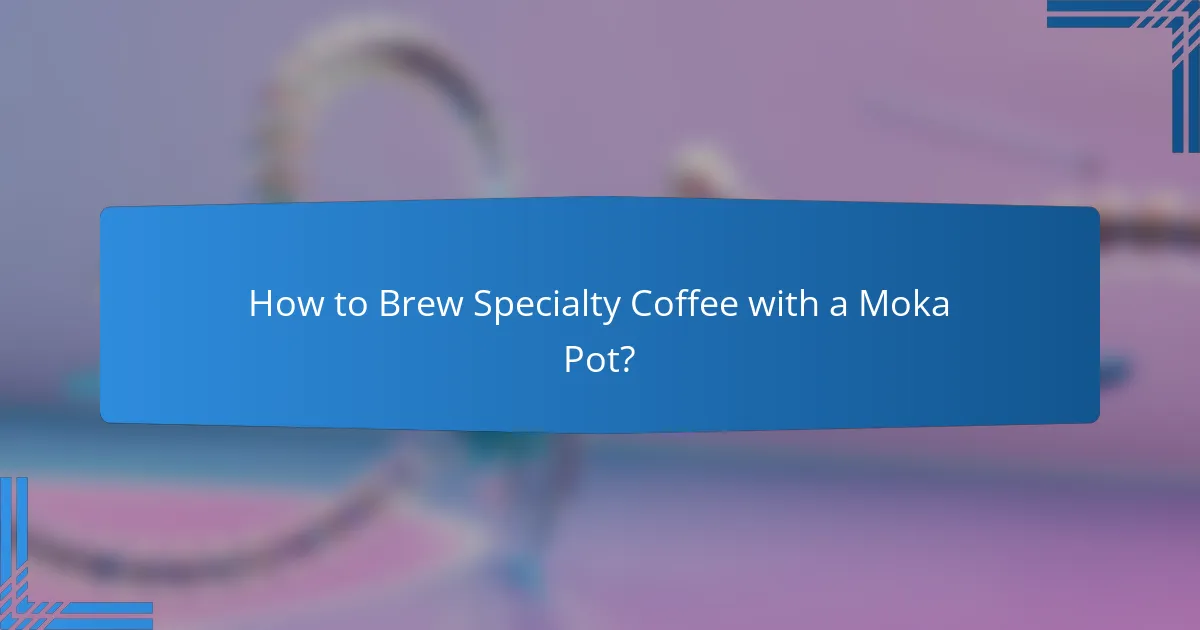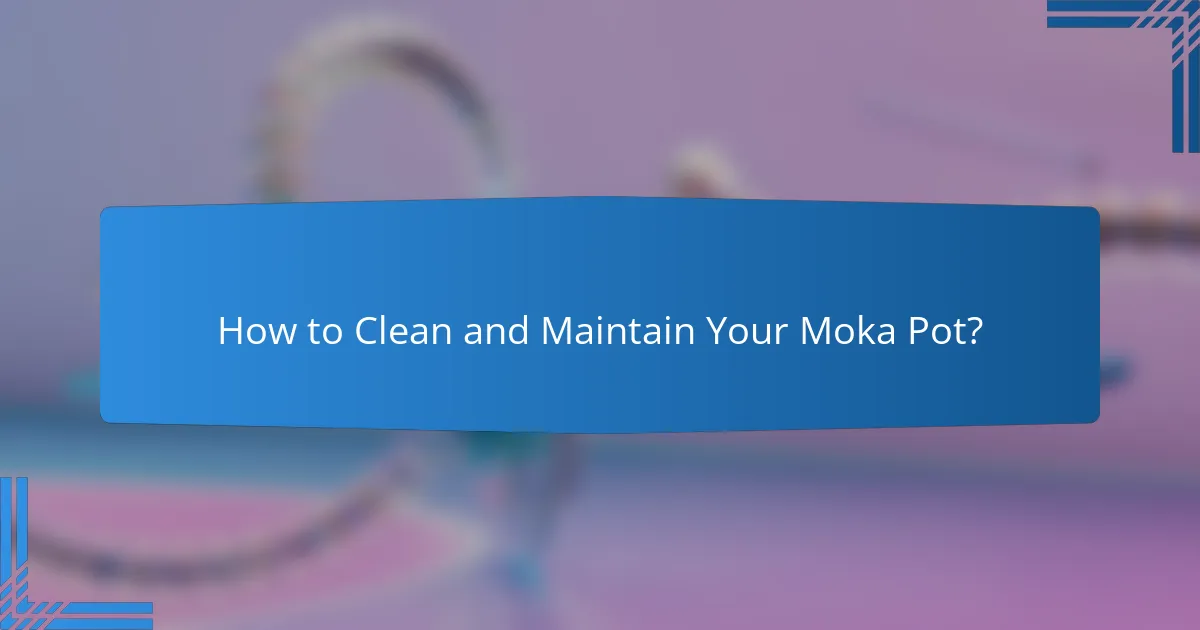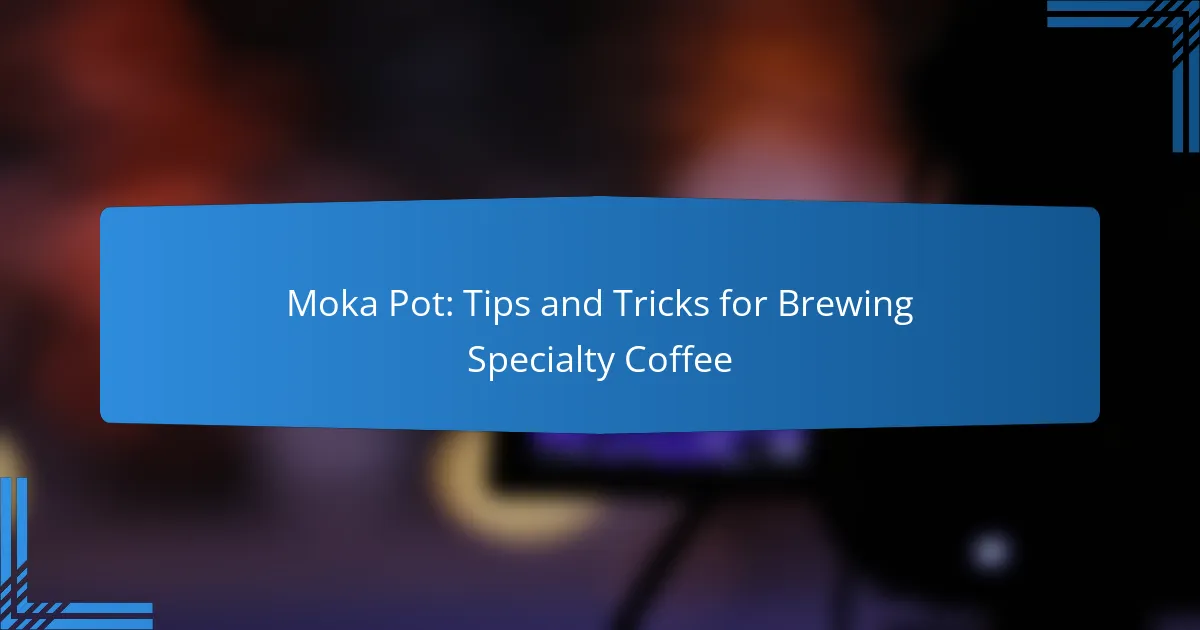Brewing specialty coffee with a Moka pot can elevate your coffee experience by focusing on the right techniques and ingredients. By selecting medium roast or specialty beans and paying attention to grind size, measurements, and heat control, you can achieve a rich and full-bodied brew. Avoid common pitfalls such as overheating and improper cleaning to ensure the best flavor and aroma from your coffee.

How to Brew Specialty Coffee with a Moka Pot?
Brewing specialty coffee with a Moka pot involves using the right techniques to enhance flavor and aroma. Key factors include grind size, accurate measurements, and controlled heat to achieve a rich, full-bodied coffee.
Use the right coffee grind
The grind size is crucial when using a Moka pot; it should be medium-fine, similar to table salt. A grind that is too coarse may result in weak coffee, while a grind that is too fine can lead to over-extraction and bitterness.
Experimenting with grind size can help you find the perfect balance for your taste preferences. A consistent grind will also ensure even extraction during brewing.
Measure water and coffee accurately
Accurate measurements of both water and coffee are essential for a balanced brew. A common ratio is about 1:7, meaning one part coffee to seven parts water, but this can vary based on personal taste.
Using a scale can help you measure precisely, ensuring that you achieve the desired strength and flavor profile every time you brew.
Heat evenly for optimal extraction
Even heating is vital for optimal extraction in a Moka pot. Use a medium flame to avoid scorching the coffee, which can happen if the heat is too high.
Consider using a heat diffuser to distribute heat evenly across the base of the pot. This will help maintain a consistent temperature throughout the brewing process.
Monitor brewing time
Brewing time significantly impacts the flavor of your coffee. Aim for a brewing time of around 4 to 5 minutes, adjusting as needed based on your grind size and heat level.
Listening for the hissing sound as the coffee brews can help you gauge when it’s almost done. Remove the pot from heat as soon as the sound changes to prevent over-extraction.
Experiment with coffee-to-water ratios
Finding the right coffee-to-water ratio can enhance your Moka pot experience. While the 1:7 ratio is a good starting point, you might prefer a stronger brew with a 1:6 ratio or a milder one at 1:8.
Keep notes on your experiments to identify which ratios produce the flavors you enjoy most. Adjusting this ratio can significantly alter the taste and strength of your coffee.

What Coffee Beans Are Best for Moka Pot Brewing?
The best coffee beans for Moka Pot brewing are typically medium roast or specialty beans that enhance the rich, bold flavors produced by this brewing method. Look for beans that are finely ground but not too powdery to ensure optimal extraction and avoid clogging the filter.
Medium roast coffee beans
Medium roast coffee beans strike a balance between acidity and body, making them ideal for Moka Pot brewing. They offer a rich flavor profile without overwhelming bitterness, which complements the brewing process. Popular varieties include Colombian and Brazilian beans, known for their smooth, well-rounded taste.
When selecting medium roast beans, aim for a grind size similar to table salt. This will help achieve a consistent extraction, resulting in a flavorful cup of coffee. Avoid overly dark roasts, as they can lead to a burnt taste in the final brew.
Single-origin coffee recommendations
Single-origin coffees are sourced from one location and often showcase unique flavor characteristics. For Moka Pot brewing, consider beans from regions like Ethiopia or Guatemala, which can provide fruity or floral notes that enhance the overall experience. These beans can elevate your coffee with distinct flavors that stand out in a Moka Pot.
Ensure that the beans are freshly roasted and ground just before brewing to maximize flavor. Look for single-origin options that are labeled as suitable for espresso or Moka Pot to guarantee the right grind and roast profile.
Specialty coffee brands to try
Several specialty coffee brands offer excellent options for Moka Pot brewing. Brands like Stumptown, Blue Bottle, and Intelligentsia provide high-quality beans that are specifically roasted for espresso and Moka Pot methods. These brands often feature tasting notes and brewing recommendations to guide your selection.
When purchasing, consider trying a variety pack to explore different flavor profiles. This will allow you to find your preferred taste while ensuring you have fresh beans on hand for your next brew. Always check for roast dates to ensure optimal freshness and flavor.

What Common Mistakes Should You Avoid?
Avoiding common mistakes when using a Moka pot can significantly enhance your coffee brewing experience. Key pitfalls include overheating the pot, using an inappropriate coffee grind, and neglecting proper cleaning and maintenance.
Overheating the Moka pot
Overheating the Moka pot can lead to burnt coffee and an unpleasant taste. It’s essential to use medium heat and monitor the brewing process closely. Ideally, the coffee should start to flow within a few minutes, and you should remove the pot from heat as soon as the bubbling sound diminishes.
To prevent overheating, consider using a stovetop diffuser or a flame tamer, which can help distribute heat evenly. This method is particularly useful if you’re brewing on a gas stove where flames can be difficult to control.
Using too fine a coffee grind
Using a grind that is too fine can cause excessive pressure buildup in the Moka pot, leading to a bitter brew or even a potential safety hazard. Aim for a medium-fine grind, similar to table salt, which allows for optimal extraction without clogging the filter.
It’s beneficial to experiment with different grind sizes to find your preferred flavor profile. If your coffee tastes overly bitter, try coarsening your grind slightly to achieve a more balanced cup.
Neglecting cleaning and maintenance
Regular cleaning and maintenance of your Moka pot are crucial for preserving the quality of your coffee. Residue buildup can affect flavor and lead to malfunction. After each use, rinse the pot with warm water and avoid using soap, which can leave unwanted flavors.
Periodically, disassemble the pot and clean all components thoroughly, including the filter and rubber gasket. This practice not only enhances the taste of your coffee but also extends the lifespan of your Moka pot.

How to Clean and Maintain Your Moka Pot?
Cleaning and maintaining your Moka pot is essential for ensuring great-tasting coffee and prolonging the life of the pot. Regular care involves disassembling and rinsing after each use, deep cleaning with vinegar periodically, and storing it properly to avoid damage.
Disassemble and rinse after each use
After brewing coffee, disassemble your Moka pot into its three main parts: the bottom chamber, the filter basket, and the top chamber. Rinse each component with warm water to remove coffee oils and residues, which can affect flavor over time.
Avoid using soap, as it can leave a residue that alters the taste of your coffee. Instead, simply rinse and let the parts air dry before reassembling.
Use vinegar for deep cleaning
For a thorough clean, use a mixture of equal parts water and white vinegar. Fill the bottom chamber with this solution and run a brew cycle without coffee. This process helps to dissolve mineral deposits and coffee oils that accumulate over time.
Afterward, rinse all parts thoroughly with warm water to remove any vinegar taste. Deep cleaning every few weeks can keep your Moka pot in optimal condition.
Store properly to prevent damage
To prevent damage, store your Moka pot in a cool, dry place. Ensure it is completely dry before putting it away to avoid rust and mold growth. Consider leaving the pot disassembled to allow air circulation.
Avoid stacking other items on top of it, as this can lead to scratches or dents. Proper storage extends the life of your Moka pot and keeps it ready for your next brew.

What Accessories Enhance Moka Pot Brewing?
To elevate your Moka pot brewing experience, consider using accessories that improve precision and quality. Key tools include coffee scales, thermometers, and quality water filters, each contributing to a more consistent and flavorful cup of coffee.
Coffee scales for precision
Coffee scales are essential for measuring the exact amount of coffee and water, which can significantly impact flavor. Aim for a coffee-to-water ratio of around 1:15 to 1:17 for optimal extraction. Using a scale allows you to replicate successful brews consistently.
When selecting a scale, look for one that measures in grams and has a tare function. This will enable you to weigh your coffee grounds without including the weight of the container.
Thermometers for temperature control
Temperature control is crucial in brewing coffee with a Moka pot, as water that is too hot can lead to over-extraction, while water that is too cool can cause under-extraction. Ideal brewing temperatures range from 90°C to 95°C (194°F to 203°F).
A digital thermometer can help you monitor the water temperature accurately. If you don’t have a thermometer, a good rule of thumb is to let the water boil and then allow it to sit for about 30 seconds before pouring it into the Moka pot.
Quality water filters
The quality of water used in brewing can greatly affect the taste of your coffee. Using filtered water can remove impurities and chlorine, which can alter flavor profiles. Aim for water with a balanced mineral content for the best results.
Consider investing in a water filter that meets your local water quality needs. A simple carbon filter can improve taste, while more advanced systems can adjust mineral levels to enhance extraction and flavor.
